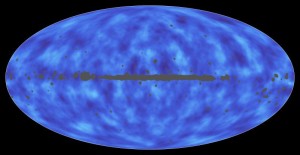Science Seen Physicist and Time One author Colin Gillespie helps you understand your world.
Lessons from Lost Worlds
In The Singular Universe and the Reality of Time Brazilian philosopher, Roberto Unger, and American physicist, Lee Smolin, team up to bring unruly mathematics and fanciful multiverses under control. They seek a renaissance of natural philosophy—ideas—as a driver of future physics. Let’s swing along with them. Central to their thesis is the idea of the entire universe:
In this book, we use the words cosmology and cosmological to designate what pertains to the universe as a whole, not just to its observable portion.
Few spend much time thinking of the universe as one thing. It’s not easy. New findings seem to warp our words. Outdated concepts bar our way. Think, for example, about: space. For eighty years we’ve known that space (and thus the whole universe) is expanding. Why do our minds recoil?
Part of our problem is we think of space as nothing. ‘How can nothing expand?’ we may ask. We have made a false assumption. Space is something. Measurements confirm the mass of space is more than double that of all the matter in the universe. Space is by far the most massive thing there is. For this new space we need a whole new way of thinking.
confirm the mass of space is more than double that of all the matter in the universe. Space is by far the most massive thing there is. For this new space we need a whole new way of thinking.
So let’s think about this space expanding. The very concept involves physics that confuses physicists. The volume of the universe increases by 0.02% per million years. The expansion doesn’t affect us, the Earth, our Solar System. Even our galaxy, the Milky Way, stays the same size. Separations of these objects and the like are fixed by gravitational relations. But most big galaxies sit amid vast reaches of space that is expanding. With no reason not to, galaxies go along with their space for the ride.
You may think: Only 0.02% per million years? It doesn’t sound like much. But general relativity says it has far-reaching consequences. More than thirteen billion years ago the most distant galaxies that can be seen with high-tech telescopes sent out the light we see today. Due to expansion those same galaxies are now forty-six billion light years away from us. And due to expansion they are moving further away at speeds that are much faster than the speed of light. (Didn’t Albert Einstein say that is impossible? No; but that’s another story.)
Those galaxies are disappearing from our view. Indeed, as we speak they give off light that will not reach the Earth; it can’t catch up to us. This offers a new way to think of our place in the universe. Around us is the Hubble sphere (twenty-eight billion light years across) inside which space, with its galaxies, recedes from us at less than light speed. Around that is a hollow sphere (ninety-two billion light years across) in which galaxies that once sent light to us are now receding faster than light. And beyond that lies the even-faster, never-to-be-seen rest of the universe.
There’s another way to think of the Hubble sphere. Data on the Milky Way from the Kepler space telescope show that most stars have planets. About one star in five is like our Sun. And, reports science writer Robert Sanders, ‘22 percent of all sun-like stars in the galaxy have Earth-size planets in their habitable zones.’ So, some four percent of Milky Way stars could support life. Other galaxies are likely much the same. There are on average about a hundred-billion stars per galaxy; and there are about a hundred-billion galaxies inside our Hubble sphere. From these numbers we can estimate how many habitable planets are heading out. The answer is (drum-roll and trumpets please): Thousands of them leave per second! This has been happening for billions of years, yet there are about a billion-trillion planets left on which life might live in galaxies we can still see.
In my view too this is the realm of future physics. The universe is vast beyond our comprehension, but not beyond our capacity to think.
Sources
Roberto Unger & Lee Smolin (2015), The Singular Universe and the Reality of Time, New York: Cambridge University Press, p. 5; http://www.cambridge.org/us/academic/subjects/physics/history-philosophy-and-foundations-physics/singular-universe-and-reality-time-proposal-natural-philosophy
(2014), “Hubble constant in percent per year”, WolframAlpha, http://m.wolframalpha.com/input/?i=Hubble+constant+in+percent+per+year&x=0&y=0
Robert Sanders (2013), “Astronomers answer key question: How common are habitable planets?”, News Center, University of California at Berkeley, November 4, http://newscenter.berkeley.edu/2013/11/04/astronomers-answer-key-question-how-common-are-habitable-planets/
Tamara Davis & Charles Lineweaver (2004), “Expanding Confusion: Common Misconceptions of Cosmological Horizons and the Superluminal Expansion of the Universe”, Pub. Astr. Soc. Aust., vol. 21, p. 97; http://arxiv.org/pdf/astro-ph/0310808
Other Material:
Habitable-planets video, http://www.space.com/23437-one-in-five-sun-like-stars-have-goldilocks-planets-video.html
Colin Gillespie (2013), Time One: Discover How the Universe Began, New York: RosettaBooks, p. 98, http://www.rosettabooks.com/book/time-one/; “The Disappearing Universe”, http://www.timeone.ca/chapters/the-disappearing-universe.pdf
Image Credit:
ESA/NASA/JPL-Caltech (2015), “Universal Matter”, Photojournal, http://photojournal.jpl.nasa.gov/catalog/PIA18914

No comments yet.